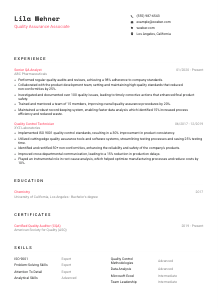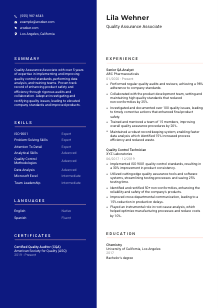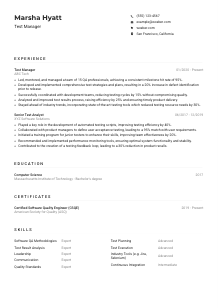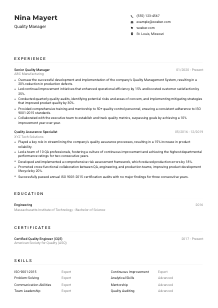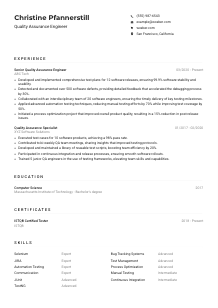Quality Assurance Associate Resume Example
Maintaining excellence, but your resume feels like it's skipping quality checks? Delve into this Quality Assurance Associate resume example, created with Wozber free resume builder. Learn how to showcase your attentiveness to detail and process compliance, positioning your career standards alongside job requirements for a spotless fit!
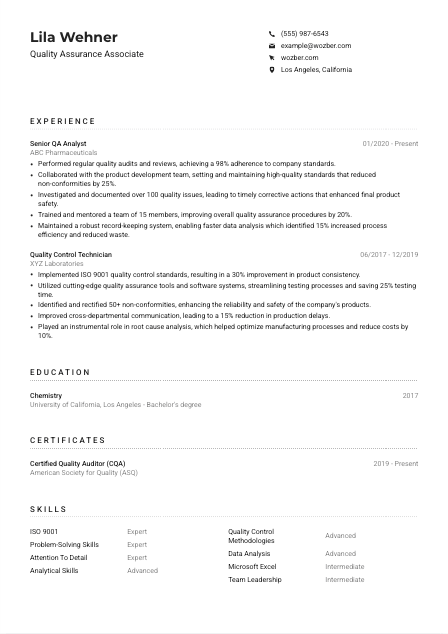
How to write a Quality Assurance Associate Resume?
Greetings, aspiring Quality Assurance Associate! If you're eager to stand out in the competitive realm of Quality Assurance, crafting a resume that resonates with precision, compliance, and attention to detail is non-negotiable. Your resume isn't just a piece of paper; it's a reflection of your commitment to quality.
With Wozber's free resume builder at your fingertips, you're about to learn how to sculpt your resume into an impeccable narrative that not only meets but exceeds job expectations. Buckle up for a detailed walkthrough customized for the Quality Assurance Associate position, leveraging our ATS-friendly resume templates and ATS resume scanner for unparalleled ATS optimization.
Personal Details
First impressions are lasting, and in the world of job applications, your Personal Details section is your opening act. Let's meticulously tailor this section, ensuring every piece of information aligns flawlessly with the Quality Assurance Associate role you're aspiring to secure.
1. Embrace Your Professional Identity
Begin with your name, prominently displayed, to cast a strong first impression. A clear, professional font is key, hinting at your attention to detail—an indispensable trait for a Quality Assurance Associate.
2. Sync With the Job Title
Aligning your professional title with the position you're applying for, in this case, 'Quality Assurance Associate,' instantly signals to hiring managers that your resume is crafted with intention. It's a strategic move to position yourself as the ideal candidate right from the start.
3. Fine-Tune Contact Information
Your contact details should be accurate and professional. A tip: use an email that incorporates your name, steering completely clear of whimsical handles. This small detail enhances your professional image significantly.
4. Location Matters
Given the job's locale requirement—Los Angeles, California—highlighting your location offers immediate assurance to employers of your availability, sparing them the concern of relocation logistics.
5. Digital Presence
If applicable, include your LinkedIn profile link, ensuring it mirrors the details of your resume. This not only provides a broader view of your professional background but also showcases your understanding of the digital dimensions of job searching.
Takeaway
Your Personal Details are the handshake before the conversation, the window to your professional persona. Precision, relevance, and professionalism here set the tone for the rest of your resume. You're not just sharing your contact information; you're inviting potential employers into your professional world. Let each detail reflect your readiness and aptitude for the Quality Assurance Associate role.





Experience
The Experience section is where your resume gets down to business, showcasing your journey and achievements in the quality assurance field. Let's refine this section to highlight your specific qualifications for the Quality Assurance Associate role, making every word count for ATS optimization.
- Performed regular quality audits and reviews, achieving a 98% adherence to company standards.
- Collaborated with the product development team, setting and maintaining high‑quality standards that reduced non‑conformities by 25%.
- Investigated and documented over 100 quality issues, leading to timely corrective actions that enhanced final product safety.
- Trained and mentored a team of 15 members, improving overall quality assurance procedures by 20%.
- Maintained a robust record‑keeping system, enabling faster data analysis which identified 15% increased process efficiency and reduced waste.
- Implemented ISO 9001 quality control standards, resulting in a 30% improvement in product consistency.
- Utilized cutting‑edge quality assurance tools and software systems, streamlining testing processes and saving 25% testing time.
- Identified and rectified 50+ non‑conformities, enhancing the reliability and safety of the company's products.
- Improved cross‑departmental communication, leading to a 15% reduction in production delays.
- Played an instrumental role in root cause analysis, which helped optimize manufacturing processes and reduce costs by 10%.
1. Dissect the Job Description
Initiate by examining the job requirements closely. Highlight phrases like 'perform regular quality audits,' 'collaborate with product development teams,' and 'train and coach team members,' as these are your keywords to integrate.
2. Organize Your History
List your roles starting with the most recent. Ensure each position includes your job title, employer's name, and your tenure. This not only showcases your journey but also demonstrates your growing expertise in the field of quality assurance.
3. Mirror Achievements with Job Needs
In your bullet points, articulate how your accomplishments align with the job requirements. For example, if you've led quality training sessions, detail how this improved team compliance with ISO 9001 standards, directly reflecting the job description's demand for training and standards adherence.
4. Quantify Success
Whenever possible, use numbers to quantify your achievements. 'Led a team that improved process efficiency by 15%' is far more impactful than 'Improved process efficiency.' Numbers draw attention and offer a clear measure of your contributions.
5. Relevance Over Volume
Quality over quantity always. Ensure each experience listed clearly ties back to the demands of a Quality Assurance Associate, weeding out unrelated roles that dilute the focus of your resume. Keep it sharp, relevant, and compelling.
Takeaway
The Experience section is your professional narrative, a testament to your journey and achievements in the realm of quality assurance. It's about making each word work towards showcasing your suitability for the Quality Assurance Associate role. Through strategic alignment with job requirements and quantifiable achievements, you're not just listing your past roles but proving your value and readiness for the next step in your career.
Education
Even in the practical, hands-on world of Quality Assurance, your educational background plays a significant role in setting the foundation of your knowledge. Let's ensure your Education section resonates with the job's requirements and underscores your suitability for the role.
1. Align With Job Demands
The job description calls for a 'Bachelor's degree in a related field like Biology, Chemistry, or Engineering.' Ensure your degree is front and center, emphatically ticking this essential box.
2. Structure for Clarity
Maintain a clean and clear format by listing your degree, field of study, institution, and graduation year. This straightforward presentation allows hiring managers to quickly verify your educational qualifications.
3. Match Your Degree
If your degree directly aligns with one of the preferred fields mentioned in the job description, like Chemistry, highlight this match to underscore your ideal fit for the role's technical demands.
4. Relevant Courses & Achievements
For fresh graduates or those with specific relevant coursework, detailing this can further illustrate your preparedness. However, for seasoned professionals, focusing on work achievements and continued learning often carries more weight.
5. Continuing Education Counts
If you've pursued relevant certificates or continuous education, these merit mention, demonstrating your commitment to staying at the forefront of quality assurance methodologies and standards.
Takeaway
Your educational background is a testament to your foundational knowledge and commitment to your field. For a Quality Assurance Associate role, emphasizing relevant degrees and continuous learning showcases not only your expertise but also your dedication to excellence in quality. Let your education section affirm your qualifications and readiness to tackle the challenges of the position.
Certificates
In the ever-evolving field of Quality Assurance, certifications can set you apart, showcasing your specialized knowledge and dedication to your craft. Let's navigate through selecting and presenting your certifications in a way that underscores your expertise for the Quality Assurance Associate role.
1. Identify Pertinent Certifications
Start by pinpointing certifications that are highly regarded in the quality assurance domain, such as 'Certified Quality Auditor (CQA)' from the American Society for Quality. While the job description may not always specify certifications, selecting those recognized in the industry speaks volumes about your professionalism and commitment.
2. Choose Quality Over Quantity
Listing certifications that directly relate to the role or industry is far more impactful than a long list of loosely related credentials. Focus on those that best showcase your expertise and dedication to the quality assurance field.
3. Date Matters
Mentioning the date of certification is especially pertinent if it's recent, showcasing your commitment to continuous learning. Conversely, if a certification has an expiration date, ensure it's current to maintain the credibility of your resume.
4. Continuously Update
The quality assurance field is dynamic, with new standards and methodologies regularly introduced. Keep your certifications up-to-date, and consider pursuing additional qualifications that bolster your expertise and demonstrate your enthusiasm for professional growth.
Takeaway
Certifications are a testament to your commitment to excellence and professional growth in the quality assurance field. They augment your resume by providing tangible evidence of your specialized knowledge and skills. To ensure your certifications section contributes to your candidacy positively, focus on relevance, timeliness, and continuous learning. These elements collectively underscore your exceptional fit for the Quality Assurance Associate role.
Skills
Your skills section is where you get to shine a spotlight on your professional toolkit, showcasing the hard and soft skills that make you the perfect candidate for a Quality Assurance Associate. Let's dive into how to tailor this section to precisely match the role's requirements.
1. Decode the Job Description
Begin by extracting key skills from the job posting. Phrases like 'strong knowledge of quality control standards and methodologies including ISO 9001' and 'proficient in the use of quality assurance tools and software systems' are your clues. These are the skills you want to highlight.
2. Prioritize Relevant Skills
Pinpoint the skills from your arsenal that align with the job description. Whether it's your expertise in ISO 9001 standards, proficiency with quality assurance software, or your analytical prowess, these need to be front and center. Remember, relevance is key.
3. Organize for Impact
Layout your skills in a manner that's easy to scan and absorbs—group similar skills together and use bullet points for clarity. Prioritizing your skills according to their importance and relevance to the role maximizes the impact of this section.
Takeaway
Articulating your skills in alignment with the job requirements not only optimizes your resume for ATS but also signals to hiring managers that you're a high-caliber match for the Quality Assurance Associate role. This section is your chance to declare, 'I have exactly what you're looking for,' making your skills impossible to overlook. Approach it with the meticulous care befitting a quality assurance professional, and let your abilities make a compelling case for your candidacy.
Languages
In the globalized context of quality assurance, language skills can significantly enhance your resume, broadening your reach and underscoring your ability to navigate diverse work environments. Let's explore how to heighten the appeal of your resume with your multilingual skills.
1. Match Job Language Requirements
The job description clearly states, 'High level of fluency in English required.' This non-negotiable requirement should be boldly addressed in your resume, positioning your English proficiency as a key asset.
2. Emphasize Key Languages
First and foremost, list English, specifying your level of proficiency. This directly responds to the job's language requirement, ensuring your resume passes both the ATS and the human eye.
3. Display Additional Languages
While the primary focus is on English, showcasing additional languages demonstrates your adaptability and global mindset—valuable assets in today's interconnected world. Just remember to be honest about your proficiency levels.
4. Honesty is the Best Policy
Clearly differentiate your language proficiencies using terms like 'Native,' 'Fluent,' or 'Intermediate.' Transparency about your language skills not only builds trust but also eliminates any ambiguities regarding your communication capabilities.
5. Consider the Role's International Aspect
For roles that might involve interaction with international clients or documents, highlighting your multilingual skills can be particularly appealing. Though our Quality Assurance Associate role focuses on English, displaying your language diversity could hint at your potential for broader responsibilities.
Takeaway
Languages are more than a means of communication; they're a bridge to understanding diverse cultures and markets. Flaunting your linguistic skills, especially when they align with the job's requirements, can significantly elevate your resume. As a Quality Assurance Associate, your ability to communicate effectively is paramount. Use the Languages section to assert your readiness for a role that demands precision, clarity, and perhaps a global perspective.
Summary
The Summary section is your opening pitch, the chance to grab the hiring manager's attention and make them want to learn more about you. Let's craft a compelling summary that aligns with the Quality Assurance Associate role, signaling both your competency and your enthusiasm for the position.
1. Distill the Job Essentials
Carefully review the job posting to understand the essence of what makes an ideal Quality Assurance Associate. Note phrases like 'excellent analytical and problem-solving skills' and 'knowledge of quality control standards like ISO 9001.' These are key points to mirror in your summary.
2. Craft a Strong Opening
Begin with a powerful introduction that encapsulates your professional identity, such as, 'Dedicated Quality Assurance Associate with over 5 years of experience...' This sets a confident tone for your resume.
3. Highlight Key Achievements and Skills
Zero in on a few pivotal achievements and skills that resonate with the job description. Mentioning your track record in 'enhancing product safety and efficiency through rigorous audits' directly links your experience with the employer's needs.
4. Keep It Snappy
Your summary should be a concise yet impactful reflection of your fitness for the role. Aim for 3-5 lines, enough to pique interest without overwhelming with details. This is your hook, make every word count.
Takeaway
Your summary is the initial handshake, the first opportunity to make an impression. By aligning it closely with the qualities sought in a Quality Assurance Associate, you're telling hiring managers, 'I'm not just a candidate; I'm the one you've been looking for.' Let your summary shine as a testament to your professionalism and your dedication to the craft of quality assurance. Remember, this is your narrative distilled to its essence. Craft it with care, wear it with pride.
Launching Your Quality Assurance Associate Journey
Congratulations on meticulously crafting your Quality Assurance Associate resume. With the insights and strategies explored here, powered by Wozber's ATS-friendly resume templates and ATS resume scanner for optimization, you're well-equipped to present a resume that not only speaks to your skills and experiences but does so in a way that resonates with hiring managers. Remember, your resume is the blueprint of your professional story. Fine-tune it, let it reflect your unique imprint, and step confidently into your next chapter.
The realm of Quality Assurance awaits your expertise and zeal. Go forth and showcase the exceptional candidate you are.

- Bachelor's degree in a related field like Biology, Chemistry, or Engineering.
- Minimum of 2 years of experience in quality assurance or a related role.
- Strong knowledge of quality control standards and methodologies including ISO 9001.
- Proficient in the use of quality assurance tools and software systems.
- Excellent analytical and problem-solving skills with attention to detail.
- High level of fluency in English required.
- Must be located in Los Angeles, California.
- Perform regular quality audits and reviews to ensure adherence to company standards.
- Collaborate with product development teams to set quality standards and specifications.
- Investigate and document quality issues, non-conformities, and corrective actions.
- Train and coach team members on quality assurance procedures and best practices.
- Maintain records of quality assurance activities and perform data analysis to identify trends and areas for improvement.





